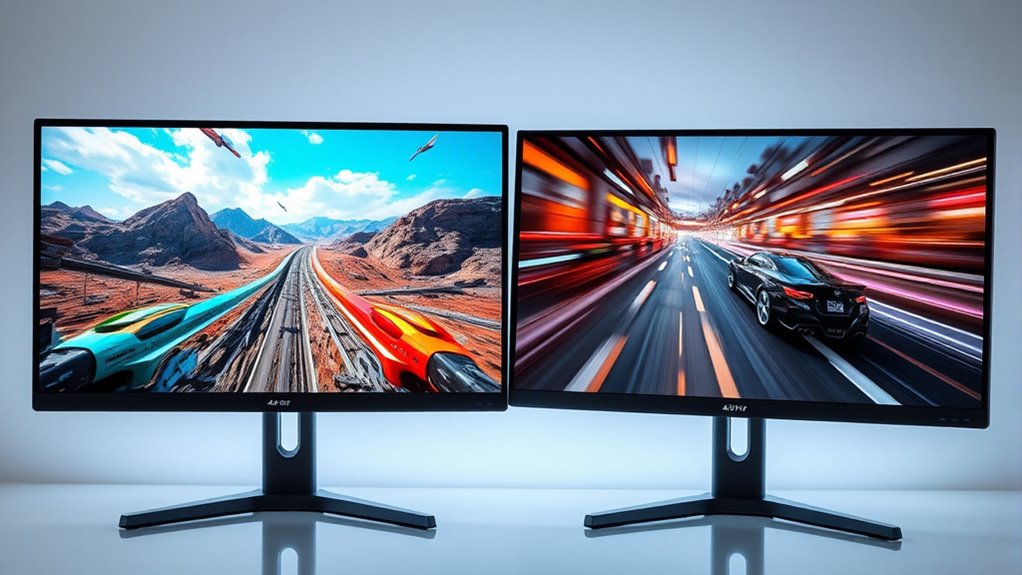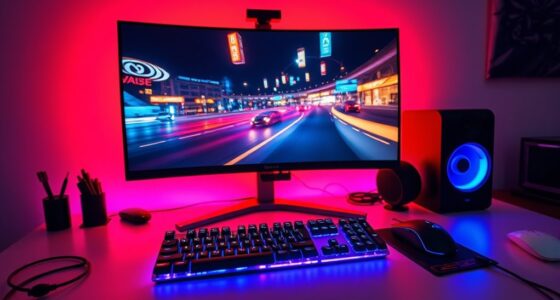If you prioritize stunning visuals, go for 4K at 60 Hz, which offers sharper details and better color accuracy, ideal for immersive experiences. If you want smoother gameplay and quicker reactions, 1080p at 120 Hz will give you much less motion blur and lower input lag, perfect for fast-paced games. To make the most of your setup and understand which option suits your gaming style, keep exploring the details ahead.
Key Takeaways
- Higher refresh rates like 1080p at 120Hz offer smoother motion and lower input lag for fast-paced games.
- 4K at 60Hz provides sharper visuals and better detail, ideal for immersive, visually rich games.
- Ensure your GPU and monitor ports support the desired resolution and refresh rate to maximize performance.
- Consider gaming genre: competitive FPS favors high refresh rates; story-driven games benefit from higher resolution.
- Balance hardware capabilities with your gaming preferences for optimal visual quality versus responsiveness.
Understanding Resolution and Refresh Rate Fundamentals
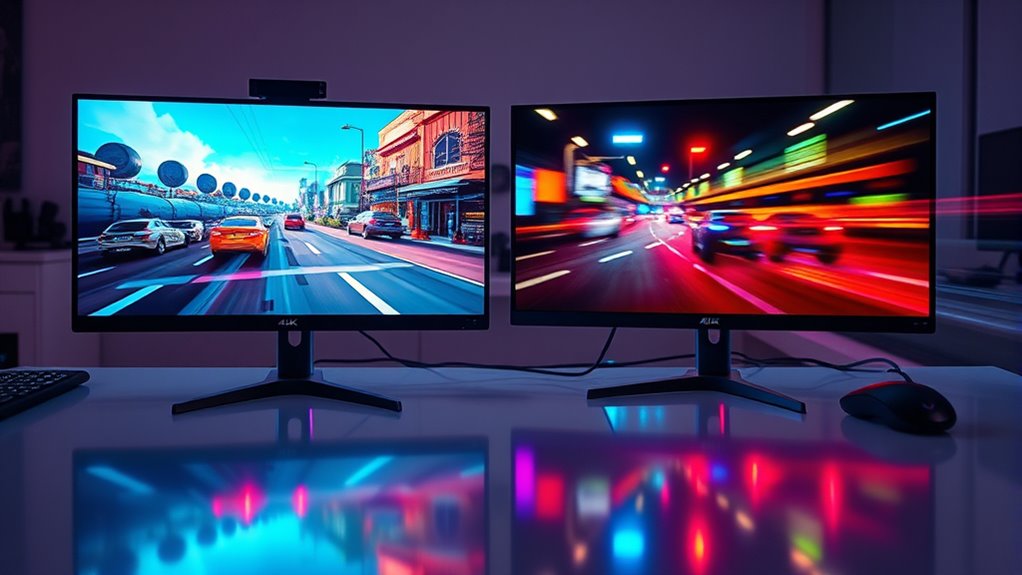
Understanding resolution and refresh rate is essential for making an informed decision about your gaming setup. Many refresh rate myths suggest higher Hz always equals better gameplay, but that’s not the full story. Refresh rate determines how many frames your monitor displays per second, impacting smoothness. Resolution refers to the image detail, with 4K offering sharper visuals than 1080p. Keep in mind that resolution scaling allows you to run games at a lower resolution while still delivering high frame rates, avoiding the misconception that higher resolution always means better performance. Balancing these factors depends on your hardware and gaming preferences. Recognizing how refresh rate and resolution interact helps you choose the right display, ensuring you get smooth gameplay without sacrificing visual fidelity. Additionally, understanding the compatibility between your GPU and monitor is crucial for optimal performance.
Visual Quality and Detail: 4K vs. 1080p
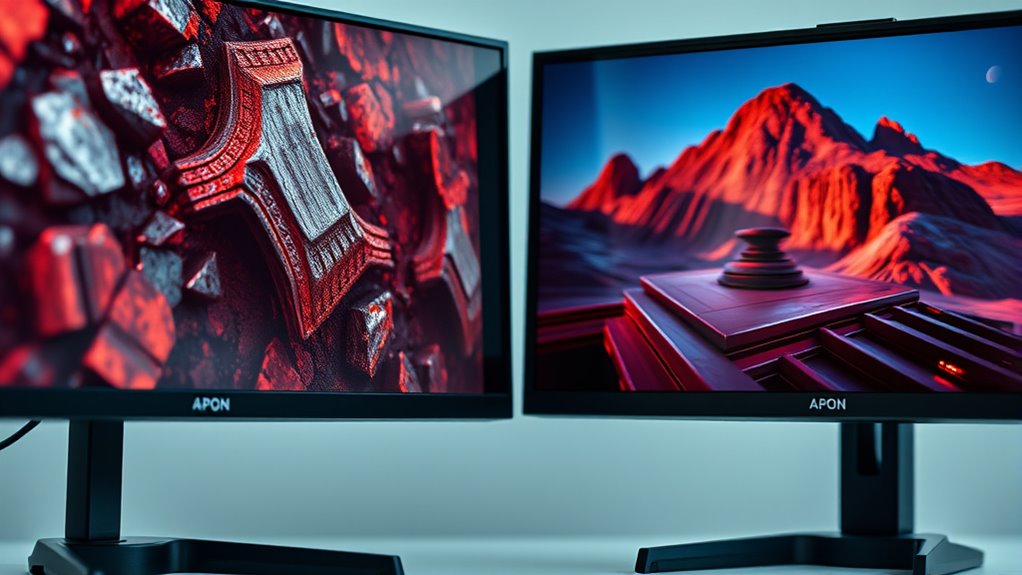
You’ll notice that 4K offers sharper clarity, making textures and details stand out more vividly. In contrast, 1080p still provides good image quality but with less fine detail. Choosing between them depends on how much you value visual sharpness versus smooth gameplay. Additionally, consider the AI safety measures implemented in modern gaming hardware to ensure a secure and reliable gaming experience.
Resolution Clarity
When comparing 4K and 1080p displays, resolution clarity plays a crucial role in your gaming experience. 4K offers four times the pixel count of 1080p, resulting in sharper images, more detailed textures, and a more immersive visual environment. Higher resolution enhances your ability to see fine details and makes gameplay more realistic. Keep in mind, though, that refresh rate and color accuracy also influence overall clarity. A higher refresh rate ensures smoother motion, reducing blurring during fast-paced scenes. Better color accuracy makes visuals more vibrant and true to life, emphasizing subtle details. To visualize:
- 4K provides sharper, crisper images than 1080p.
- It reveals finer textures and intricate details.
- Color accuracy enhances visual vibrancy and realism.
- Understanding visual clarity factors helps optimize your gaming setup for the best experience.
Texture and Detail
Moving beyond resolution clarity, the level of detail and texture in a game substantially impacts how immersive it feels. At 4K, texture enhancement reveals intricate surfaces and fine details, making environments more realistic. In contrast, 1080p may sacrifice some detail preservation, but still offers sharp textures with less demand on hardware. Your choice affects visual richness and performance balance. Here’s a quick comparison:
| Aspect | 4K 60 Hz | 1080p 120 Hz |
|---|---|---|
| Texture Quality | Superior texture enhancement, detailed surfaces | Good textures, but less refined |
| Detail Preservation | High, retains fine environmental details | Moderate, some details may blur |
| Immersion | Higher due to richer textures | Good, with smoother motion |
| Hardware Demand | Higher, needs powerful GPU | Lower, easier on system resources |
Additionally, consider visual fidelity and how it influences overall gaming experience when making your decision.
Smoothness and Responsiveness in Gameplay
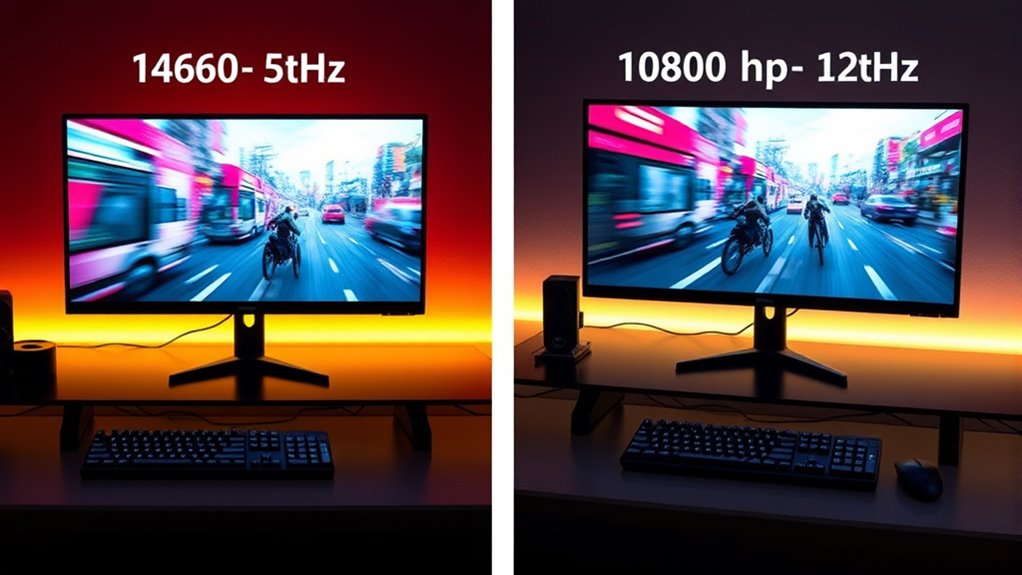
Smoothness and responsiveness are essential for an engaging gaming experience, and they often depend on the refresh rate and resolution of your display. A higher refresh rate reduces motion blur and makes fast movements look smoother, while lower input lag ensures your commands register quickly. To optimize your gameplay, consider these points:
- A 1080p 120 Hz monitor offers smoother visuals during rapid movements, reducing motion sickness.
- A higher refresh rate decreases input lag, giving you a competitive edge in fast-paced games.
- While 4K 60 Hz provides sharp visuals, it may feel less responsive due to the lower refresh rate, impacting your reaction times.
- Refresh rate directly influences how fluid the motion appears, which is crucial for fast-paced gaming scenarios.
Choosing the right setup depends on balancing visual detail with smooth, responsive gameplay.
Hardware Requirements and Compatibility
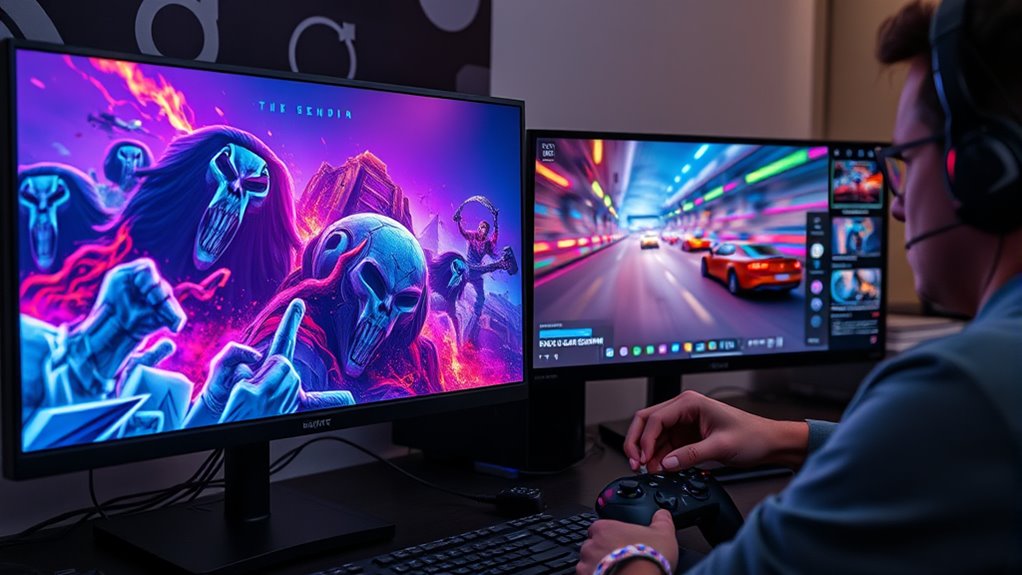
To enjoy either gaming setup, your hardware needs to meet specific requirements. You’ll need a powerful GPU that can handle 4K 60 Hz or high-refresh-rate 1080p gaming smoothly. Also, check that your display has compatible ports and supports the resolution and refresh rate you want to use. Ensuring the bedroom layout accommodates your gaming setup can enhance comfort and accessibility during long gaming sessions.
GPU Power Needs
Choosing between 4K 60 Hz and 1080p 120 Hz gaming setups requires careful attention to your GPU’s power needs. Your graphics card’s power consumption directly impacts system stability and performance. Higher resolutions and refresh rates demand more from your GPU. Consider these key points:
- The more demanding the graphics card, the greater the power consumption.
- Upgrading to a high-end GPU requires a robust power supply unit (PSU).
- Compatibility with your PSU ensures your GPU functions efficiently without crashes or throttling.
- Ensuring your GPU supports high refresh rates is essential for optimal gaming performance.
A GPU with higher power needs may require additional power connectors or a more powerful PSU. Ensuring your system can handle your graphics card’s power demands is critical to avoid bottlenecks and maintain smooth gameplay.
Display Compatibility Checks
Are your current hardware components compatible with the display resolution and refresh rate you want to use? Make certain your GPU can handle the chosen resolution without excessive resolution scaling, which can reduce image clarity. Check if your graphics card supports 4K at 60 Hz or 1080p at 120 Hz natively, as some older models may struggle. Additionally, verify that your monitor’s color accuracy aligns with your needs, especially if you prioritize vivid visuals. Your CPU and RAM should also support smooth gaming at these settings. Keep in mind that resolution scaling can impact performance and image sharpness, so confirm that your hardware can deliver stable frame rates at your preferred resolution and refresh rate. Proper hardware compatibility guarantees an ideal gaming experience without unnecessary compromises.
Connection Port Requirements
Ensuring your graphics card and monitor have compatible connection ports is essential for achieving ideal display performance. Without the right ports, you can’t fully utilize 4K at 60 Hz or 1080p at 120 Hz. First, check if your setup uses HDMI 2.0 or newer, which supports 4K 60 Hz and high refresh rates. Second, DisplayPort 1.4 or newer is ideal for higher resolutions and refresh rates, especially for gaming. Third, consider your wireless connections and audio interfaces; some monitors offer USB-C or Thunderbolt ports that combine video, audio, and data transfer. These versatile options simplify cabling and improve compatibility. Ensuring your ports meet these requirements guarantees smooth gameplay, crisp visuals, and seamless audio experiences. Additionally, understanding connection port standards helps optimize your setup for the best gaming performance.
Gaming Genres and Optimal Settings
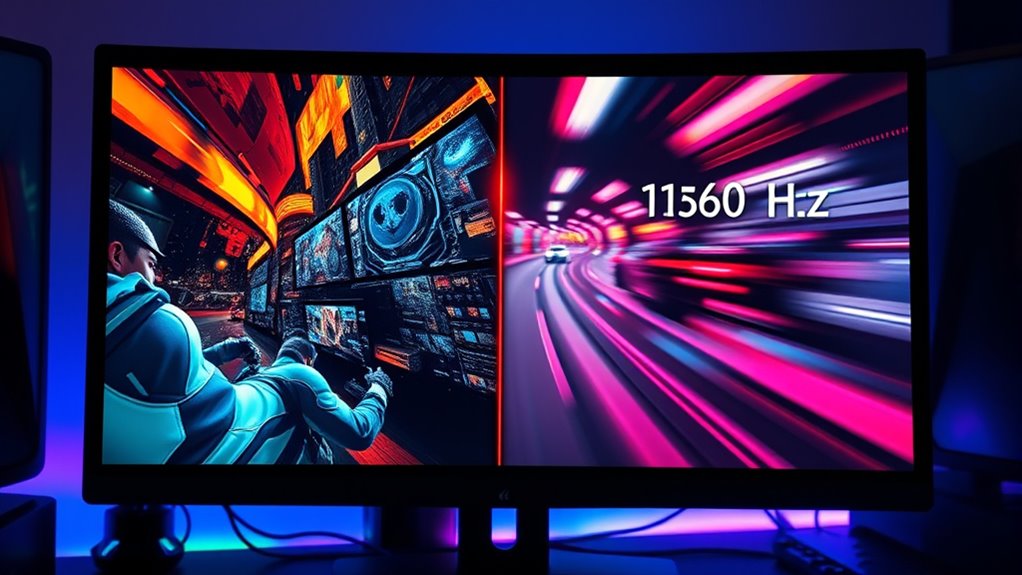
Different gaming genres have unique demands that influence the ideal display settings. For fast-paced shooters or competitive games, you’ll want higher frame rates to ensure smooth gameplay and precise timing, making 1080p at 120 Hz appealing. In these genres, resolution scaling might be necessary to maintain high frame pacing without sacrificing responsiveness. Conversely, story-driven or visually rich RPGs benefit from higher resolution, where 4K at 60 Hz can showcase detailed environments and textures. Consider how each genre prioritizes visual fidelity versus fluidity. Adjusting resolution scaling helps balance performance and image quality, guaranteeing your game runs smoothly without compromising immersion. Choosing the right settings depends on your preferred genre and what aspects you value most: sharpness or responsiveness. Additionally, utilizing gaming-specific display features such as variable refresh rate technology can further optimize your gaming experience by reducing screen tearing and input lag.
Making the Best Choice for Your Setup
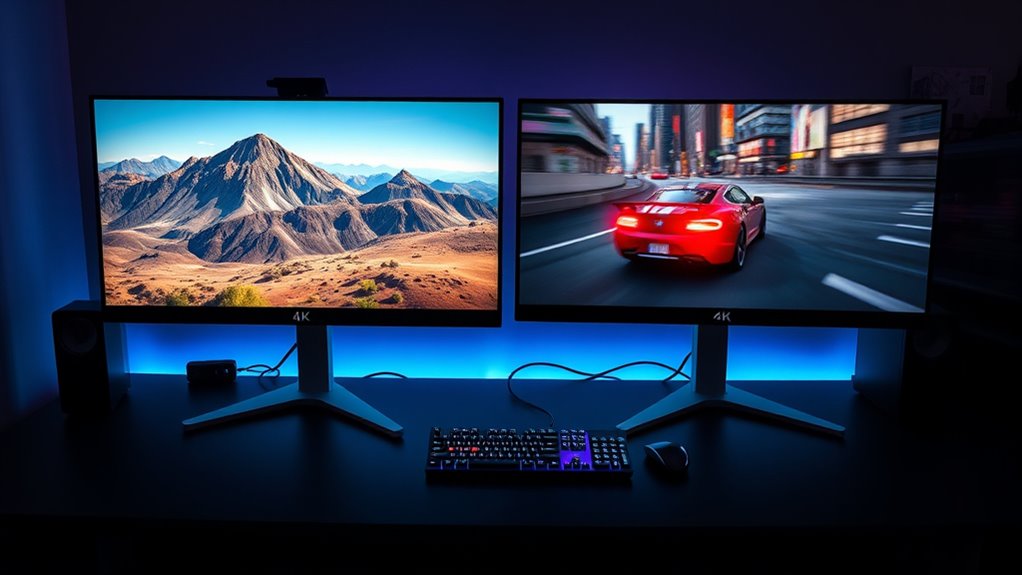
Choosing the best display setup depends on your gaming preferences, hardware capabilities, and the types of games you play most often. To make the right choice, consider these factors:
- Prioritize color accuracy if you value vivid visuals, making 4K 60 Hz appealing for immersive experiences.
- For competitive gaming where smooth motion matters, 1080p at 120 Hz provides higher frame rates and fluid gameplay.
- Ensure audio synchronization aligns with your setup—higher refresh rates can sometimes cause slight audio delays, so check compatibility and adjust settings accordingly.
Your setup should balance resolution, refresh rate, and technical features like color accuracy and audio sync to optimize your gaming experience. This way, you’ll enjoy both visual fidelity and responsive performance tailored to your gaming style.
Frequently Asked Questions
How Does HDR Impact Gaming Quality at 4K and 1080P?
HDR impact profoundly enhances gaming quality at both 4K and 1080p, making visuals more vibrant and realistic. It improves color accuracy, so your game environments look richer and more detailed. Whether you’re gaming at 4K or 1080p, HDR adds depth to shadows and brightness, creating a more immersive experience. The overall effect is sharper, more dynamic images that boost your enjoyment and help you better appreciate the game’s visual design.
Can I Upgrade My Current Graphics Card for Better 4K or 120HZ Performance?
Yes, upgrading your graphics card can boost your gaming performance, whether you want smoother 4K visuals or higher frame rates at 1080p. It helps eliminate performance bottlenecks, allowing you to push settings higher and get better visuals. Just make certain your new card is compatible with your system and meets the demands of your preferred resolution and refresh rate. A quality upgrade makes a noticeable difference in gameplay quality.
What Cables or Ports Are Needed for 4K 60HZ and 1080P 120HZ?
Oh, you’re surprised you need specific cables and ports for ideal gaming? Well, for 4K 60Hz, you’ll want HDMI 2.0 or DisplayPort 1.4, while 1080p 120Hz requires HDMI 2.0 or DisplayPort 1.2. Make sure your cable requirements match your port specifications; otherwise, you risk blurry images or lag. It’s simple—use the right cables and ports, and you’ll enjoy smooth gaming without any fuss.
How Does Latency Differ Between 4K 60HZ and 1080P 120HZ?
You’ll notice that 1080p 120Hz typically offers lower latency because of faster response times and reduced input lag, giving you a more responsive gaming experience. In contrast, 4K 60Hz tends to have higher latency due to the increased resolution and longer processing times. If quick reactions matter most, 1080p 120Hz delivers a more immediate and smoother response, making it ideal for fast-paced games.
Are There Specific Monitors Optimized for Both High Resolution and High Refresh Rate?
Did you know that some monitors combine 4K resolution with refresh rates up to 144Hz? You can find models optimized for both high resolution and high refresh rate, ensuring smooth gameplay and sharp visuals. When choosing, check the monitor’s compatibility with your GPU and its supported refresh rate. These monitors are perfect if you want stunning visuals without sacrificing the fluidity needed for fast-paced gaming.
Conclusion
Ultimately, choosing between 4K 60Hz and 1080p 120Hz depends on what matters most to you—sharper visuals or smoother gameplay. Remember, “the best is the enemy of the good”; sometimes, prioritizing one aspect means sacrificing another. Consider your gaming style, hardware, and preferences, and you’ll find the perfect fit. Whichever route you take, enjoy your gaming journey—balance and choice lead to the best experience.
